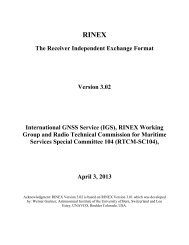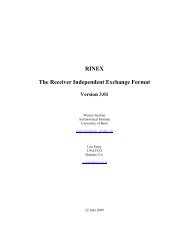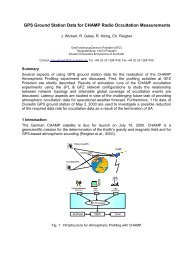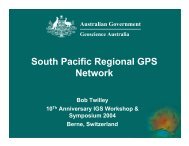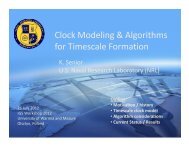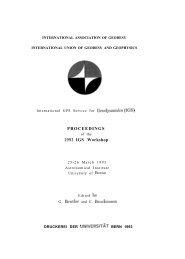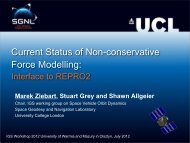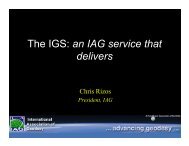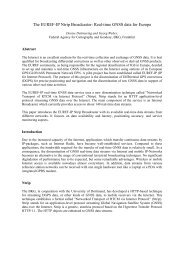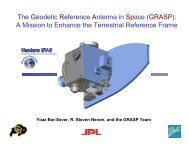need to be developed. It would be natural for RAC’S and NAC’S to be, in official <strong>IGS</strong>terms, “Associate <strong>Analysis</strong> <strong>Center</strong>s.”(ii) GAC’S produce and distribute, in addition to orbit and EOP solutions, “daily” fiducialfreenetwork solutions, station and satellite clock solutions and tropospheric calibrations.(iii) <strong>IGS</strong> encourage research into network combination, especially by the NAC’S whichperform the routine work.(iv) <strong>IGS</strong> develop and decide upon formats for the additional products described in thisdocument.(v) The type of activities sketched in this document begin as soon as possible, since theglobal network is very rapidly becoming unmanageable.(vi) RAC’S and NAC’S send summary reports via <strong>IGS</strong>REPORTS e-mail, and send theirproducts to the data centers.(vii) <strong>IGS</strong> Central Bureau prepare itself for assessing contributions from GAC’S, RAC’Sand NAC’S, providing routine feedback, and providing general oversight to see that thenew system evolves in a rational way. <strong>IGS</strong> Central Bureau (in consultation with IERS) isalso responsible for overseeing the production of the standard frame.(viii) <strong>IGS</strong> Central Bureau prepare itself for serving regional users (e.g., providing clearinstructions, recommendations, help, etc.).Y(ix) Data centers prepare themselves for the additional burden of making available the newproducts described in this document.ACKNOWLEDGMENTS. We thank Bob King for reviewing this paper and forproviding useful comments, and Jie Zhang, Eric Calais, S.S,0. Puntodewo, Jeff Genrichand Jim Zumberge for contributing research material and figures. The research describedin this paper was carried out in part by the Jet Propulsion Laboratory, California Institute ofTechnology under a contract with the National Aeronautics and Space Administration.Research at S10 is supported by the National Aeronautics and Space Administration(NAGS- 1917), the National Science Foundation (EAR 92 08447), the Southern CaliforniaEarthquake <strong>Center</strong> USGS cooperative agreement (14-08 -00001 -A0899) and the U.S.Geological Survey (1434-92-G2196).REFERENCESArgus, D.F. and R.G. Gordon, No-Net-Rotation model of current plate velocitiesincorporating plate rotation model NUVEL- 1, Geophys. Res. fitt., 18, 2039-2042,1991 0Beutler, G. and E. Brockman, eds., Proceedings of the 1993 <strong>IGS</strong> <strong>Workshop</strong>, Inte~ationalAssociation of Geodesy, Druckerei der Universitat Bern, 1993.Bierman, G.J., Factorization methods for discrete sequential estimation, Academic Press,San Diego, Ca.lif., 1977.Blewitt, G., Carrier phase ambiguity resolution for the Global Positioning System appliedto geodetic baselines up to 2000 km, J. Geophys. Res., 94, 10,187-10,283, 1989.Blewitt, G., M.B. Heflin, K,J. Hurst, D.C. Jefferson, F.H. Webb and J.F. Zumberge,Absolute far-field displacements from the June 28, 1992, Landers earthquakesequence, Nature, 361, 340-342, 1993.89
Bock, Y., R.I. Abbot, C.C. Counselman, S.A. Gourevitch, and R.W. King,Establishment of three-dimensional geodetic control by interferometry with the GlobalPositioning System, J. Geophys. Res., 90, 7689-7703.1985.Bock, Y., and Shimada, S., Continuously monitoring GPS networks for deformationmeasurements, Global Positioning System: An Overview, Bock, Y. & Leppard N.,cd., Springer Verlag, New York, 40-56, 1990.Bock, Y., Continuous monitoring of crustal deformation, GPS World, Aster PublishingCorporation, Eugene, Oregon, 40-47, June Issue, 1991.Bock. Y., Agnew, D, C., Fang, P., J.F. Genrich, B.H. Hager, T.A. Herring, K.W.Hudnut, R,W, King, S. Larsen, J-B. Minster, K. Stark, S. Wdowinski and Wyatt,F. K., Detection of crustal deformation from the Landers earthquake sequence usingcontinuous geodetic measurements, Nature, 361, 337-340, 1993.Calais, E., Y. Bock, J. Genrich, P. Fang, R. McCaffrey, Fauzi, C. Stevens, S.S.0.Puntodewo, J. Rais, C. Subarya, P. Tregoning and F. Brunner, Southeast Asiakinematics and the International Terrestrial Reference Frame from GPS, Eos. Trans.AGU, 74, 194, 1993.Dong, D., The horizontal velocity field in southern California from a combination ofterrestrial and space-geodetic data, PhD thesis, Massachusetts Institute of Technology,1993..Draggert, H., X. Chen and J. Kouba, GPS monitoring of crustal strain in southwestBritish Columbia with the Western Canada Deformation Array, Eos Trans. AGU, 74,60, 1993,Feigl, K, L,, D,C. Agnew, Y. Bock, D. Dong, A. Donnellan, B.H. Hager, T.A. Herring,D.D. Jackson, T.H. Jordan, R.W. King, S, Larsen, K.M. Larson, M.H. Murray, Z.Shen and F.H, Webb, Measurement of the velocity field of central and southernCalifornia, 1984-1992, J. Geophys. Res., in press, 1993.Genrich, J., Y. Bock, E. Calais, R, McCaffrey, Fauzi, C. Stevens, P. Zwick, S.S.0.Puntodewo, J. Rais, C. Subarya, P. Tregoning and F. Brunner, Contemporary crustaldeformation in Indonesia: Sumatra fault transects and Flores earthquake studies, EosTrans. AGU, 74, 191, 1993.Heflin, M.B., W.I. Bertiger, G. Blewitt, A.P. Freedman, K.J. Hurst, S.M. Lichten, U.J.Lindqwister, Y. Vigue, F.H, Webb, T.P. Yunck, and J.F. Zumberge, Global geodesyusing GPS without fiducial sites, Geophys. Res. Lett., 19, pp. 131-134, 1992.Herring, T. A., J.L. Davis, J.L, and 1.1. Shapiro, Geodesy by radio interferometry: Theapplication of Kalman Filtering to the analysis of very long baseline interferometrydata, J. Geophys. Res. 95, 12,561-12,583, 1990.Herring, T. A., D. Dong, and R,W. King, Sub-milliarcsecond determination of poleposition using Global Positioning System data, Geophys, Res. Lett., 18, 1893-1896,1991.Herring, T. A., Documentation of the GLOBK Software, Mass. Inst. of Technology,1993.Jet Propulsion Laboratory, An introduction to GIPSY/OASIS-11: Precision software for theanalysis of data from the Global Positioning System (Course notes at BoulderColorado, July 1993), Ed. by F.H. Webb and J.F. Zumberge, Jet PropulsionLaboratory, Pasadena, Calif., 1993.King R.W. and Bock, Y., Documentation of the GAMIT GPS <strong>Analysis</strong> Software, Mass.Inst. of Technology and Scripps Inst. of Oceanography, 1993.Lindqwister, U., Blewitt G., Zumberge J. and Webb F., Millimeter-level baselineprecision results from the California permanent GPS Geodetic Array, Geophys. Res.Letf., 18, 1135-1138, 1991.Minster, J. B., B .H. Hager, W.H. Prescott and Robert E. Schutz, International globalnetwork of fiducial stations, U.S. National Research Council Report, NationalAcademy Press, Washington, D.C., 1991.Puntodewo S. S.0., R. McCaffrey, E. Calais, Y. Bock, J. Rais, C, Subarya, R.Poewariardi, C. Stevens, J. Genrich, Fauzi and P. Zwick, GPS measurements of.490




